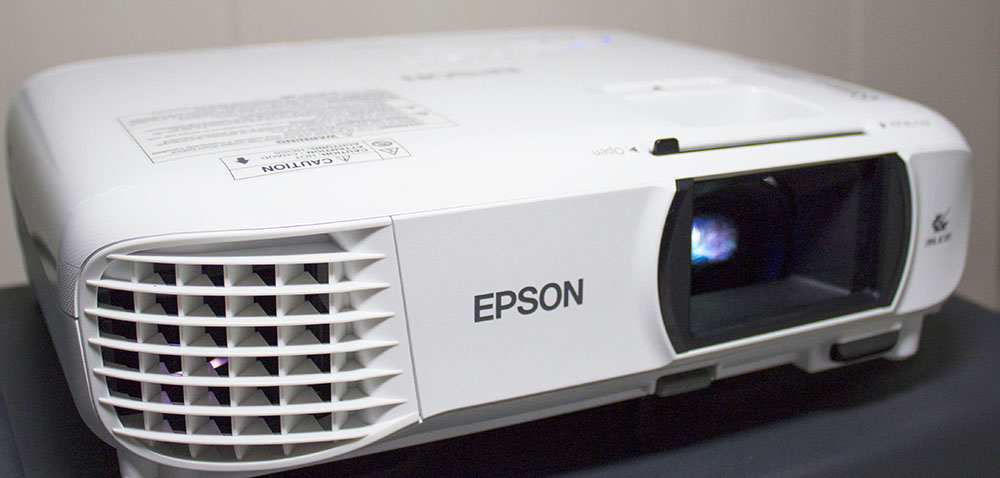Search

Epson Home Cinema 1060: Full HD Projector with Rich Colors and Versatile Connectivity

If you’re looking for the bright home theater projector that supports Full HD and wireless connectivity and won’t empty your pocket, take a closer look at the Epson - Home Cinema 1060 1080p 3LCD projector - white model. This unit ensures optimal color balance and saturation in any environment, from completely dark to well-lit rooms, and is free from the rainbow effect present in the DLP-based models of the same price tier.
With this projector, you can hook up multiple devices including the streaming appliances. The installation options are many thanks to the multiple regulation mechanisms available (lens adjustment, keystone regulation, zoom).
Design
Design isn’t the primary highlight of the Epson Home Cinema 1060 review, while there are some features differing this model from others. The box is small and would fit any cabinet with a height of 3.6 inches (it’s 11.9 inches wide and 9.9 inches deep). The top panel has typical for Epson projectors controls including the navigation buttons set and zoom, focus and operation modes switches and dials. The front panel has the elongated lens window and the small grill with a curved shape at the corner.
The unit has rubberized feet ensuring its stable position when installed on the table top or a shelf. It weighs just 5.6 lbs, which makes it portable and easy-to-mount on the ceiling and other mounting positions. The included remote is multifunctional, with the color-coded sets of buttons.
Features
The Epson Home Cinema 1060 creates 2 million pixels supporting the 1080p video format. With the brightness of 3,100 lumens, it surpasses many competitor models. The absence of 3D compatibility, though, might become a deal-breaker for some users.
The picture can be zoomed 1.2X, and the throw distance on this projector is quite short. The detailed and sharp 100-inch image is reached at a distance of 7.2ft, which makes the device suitable for small rooms. Both lens and keystone on the Epson 1060 can be regulated vertical and horizontally ensuring the square display at various mounting positions.
The wireless connectivity is represented by built-in Wi-Fi used for screen mirroring and streaming (through relevant appliances). The physical ports make two HDMI (one with MHL protocol) ports, the USB type A and service ports, component and composite inputs, the VGA port. The integrated mono speaker has 2W capacity.
Performance
The highlight of the Epson 1060 review is its high brightness that makes both colored and white fragments look solid and natural. The brightness distribution is even over the screen, without washed out or poorly detailed spotsThe wide color gamut exceeding 1 billion colors results in the multiple hues with fine detail and smooth transitions. Blacks, however, aren’t that impressive and might seem blurred or washed out in the well-lit room.
The HC1060 has good contrast, which is subject to the picture mode chosen. In the Cinema mode, the contrast is the highest, while the Eco mode might result in dirty effect for grey shades. The color accuracy is high, while in the brightest mode, the greens might feel a bit oversaturated.
The speaker used on Epson 1060 projector is audible in the small room but can be easily overlapped with the ambient noise or diffused in larger space. The unit might emit noticeable noise at high load (37 dB) but turn very quiet in the Eco mode (28 dB).
The projector features a fast response and works well as a PC display. Meanwhile, the 50ms input lag is too big for dynamic video games.
More DetailsKey Specifications
Pros
- Portable and lightweight
- Flexible screen size
- 3D capability
Cons
- Higher price point

Key Specifications
Pros
- Rich color and accurate blending provide a lifelike dynamic picture.
- Functional handy remote with good buttons onset.
- The projector features both audio input & output enabling the connection of the external speaker.
Cons
- Blacks are a bit washed out in the light environment.
- The projector is demanding for upgraded HDMI cables (otherwise no signal is transmitted).

Key Specifications
Pros
- It has a low level of heat emission during work.
- Its high brightness level makes it work well in good light conditions.
Cons
- It has only vertical keystone adjustment.
- The projector shows some colorful flashes in black-and-white videos.